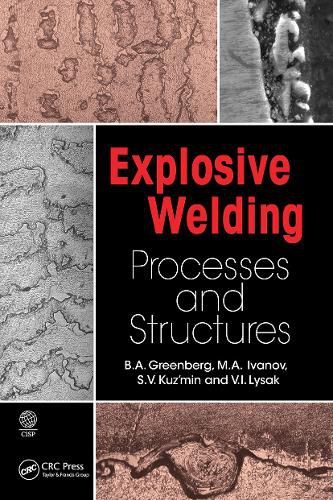Readings Newsletter
Become a Readings Member to make your shopping experience even easier.
Sign in or sign up for free!
You’re not far away from qualifying for FREE standard shipping within Australia
You’ve qualified for FREE standard shipping within Australia
The cart is loading…






This reference explores explosion welding, a high intensity, transient impact that achieves metal compounds not obtainable otherwise. Electron microscopy images cover the structure of numerous welded joints including titanium-orthorhombic titanium aluminide, copper-tantalum, aluminum-tantalum, iron-silver, steel-steel, and copper-titanium. These weldable pairs have different solubility than their initial elements. The authors present various processes and structures including granulating fragmentation, cusps, splashes, and quasi-wave interface. Specific risk zones for chemical and petrochemical (coke chamber) reactors are probed and suggestions offered.
Key Features:
Offers new theories about explosion welding processes and structures Investigates dozens of weldable pairs with differing solubility from initial elements Studies both hetero- and homogeneous pairs Explores welded joints with flat, wavy and quasi-wavy separation boundaries Observes irregularities of the separation surface relief observing asperities and splashes and their transformation under intensified welding modes Unveils a new type of fragmentation under explosion welding
Explosive Welding: Processes and Structures is a valuable resource for a wide range of experts involved in explosion welding, engineers, as well as graduate and postgraduate students.
$9.00 standard shipping within Australia
FREE standard shipping within Australia for orders over $100.00
Express & International shipping calculated at checkout
This reference explores explosion welding, a high intensity, transient impact that achieves metal compounds not obtainable otherwise. Electron microscopy images cover the structure of numerous welded joints including titanium-orthorhombic titanium aluminide, copper-tantalum, aluminum-tantalum, iron-silver, steel-steel, and copper-titanium. These weldable pairs have different solubility than their initial elements. The authors present various processes and structures including granulating fragmentation, cusps, splashes, and quasi-wave interface. Specific risk zones for chemical and petrochemical (coke chamber) reactors are probed and suggestions offered.
Key Features:
Offers new theories about explosion welding processes and structures Investigates dozens of weldable pairs with differing solubility from initial elements Studies both hetero- and homogeneous pairs Explores welded joints with flat, wavy and quasi-wavy separation boundaries Observes irregularities of the separation surface relief observing asperities and splashes and their transformation under intensified welding modes Unveils a new type of fragmentation under explosion welding
Explosive Welding: Processes and Structures is a valuable resource for a wide range of experts involved in explosion welding, engineers, as well as graduate and postgraduate students.